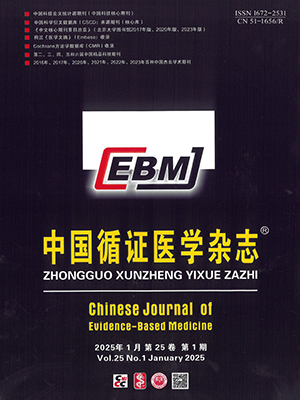| 1. |
杨世民, 胡明. 药事管理学(第六版). 人民卫生出版社, 2014, 215-216.
|
| 2. |
国家药典委员会. 中华人民共和国药典. 一部. 北京: 化学工业出版社, 2015, 1-5.
|
| 3. |
国务院关于印发中医药发展战略规划纲要(2016—2030)年的通知(国发〔2016〕15号). 北京: 中共中央国务院. Avaliable at: .
|
| 4. |
陈新谦, 金有豫, 汤光, 等. 新编药物学. 第十七版. 北京: 人民卫生出版社, 2011: 657-662.
|
| 5. |
Shea BJ, Grimshaw JM, Wells GA, et al. Development of AMSTAR: A Measurement Tool to Assess Systematic Reviews. BMC Med Res Method, 2007, 7(10): 1-7.
|
| 6. |
李幼平, 杨克虎. 循证医学, 第二版. 人民卫生出版社, 2014, 189-191.
|
| 7. |
陈耀龙, 姚亮, Norris S, 等. GRADE 在系统评价中应用的必要性及注意事项. 中国循证医学杂志, 2013, 13(12): 1401-1404.
|
| 8. |
Guyatt GH, Oxman AD, Vist GE, et al. GRADE: 证据质量和推荐强度分级的共识. 中国循证医学杂志, 2009, 9(1): 8-11.
|
| 9. |
Balshem H, Helfanda M, Holger J, et al. Schunemann GRADE 指南: Ⅲ. 证据质量分级. 中国循证医学杂志, 2011, 11(4): 451-455.
|
| 10. |
潘兴丰, 叶海东. 参松养心胶囊治疗冠心病心绞痛 Meta 分析. 中国中医药科技, 2014, 21(6): 708-710.
|
| 11. |
刘学会, 周芳, 樊光辉, 等. 川芎嗪注射液治疗冠心病心绞痛随机对照试验的系统评价. 现代中西医结合杂志, 2014, 23(8): 810-812.
|
| 12. |
石亚飞, 闫荟, 孙世光, 等. 两种丹参类中药注射剂治疗冠心病心绞痛的系统评价及其药物经济学分析. 中国循证医学杂志, 2014(3): 287-291.
|
| 13. |
徐国良, 曹鸿雁, 徐卉, 等. 舒血宁注射液与丹参注射液治疗心绞痛有效性及安全性的 META 分析. 时珍国医国药, 2011, 22(8): 2028-2030.
|
| 14. |
贾永亮, 张时开, 鲍菲飞, 等. 通心络胶囊与丹参滴丸治疗冠心病心绞痛间接比较的系统评价. 中国循证医学杂志, 2011, 11(8): 919-931.
|
| 15. |
杨巧宁, 谷丰, 高铸烨, 等. 冠心丹参滴丸治疗冠心病随机对照试验的系统评价. 中国试验方剂学杂志, 2014, 20(16): 218-224.
|
| 16. |
徐秀余, 吴云敏, 陈潇潇, 等. 丹参酮 ⅡA 磺酸钠治疗不稳定型心绞痛的疗效与不良反应的 Meta 分析. 海峡药学, 2014, 26(3): 114-117.
|
| 17. |
王承龙, 谷丰, 王少丽, 等. 丹参酮 ⅡA 磺酸钠治疗冠心病心绞痛随机对照试验的 Meta 分析. 中西医结合心脑血管病杂志, 2011, 9(6): 644-647.
|
| 18. |
闫薇薇, 徐国良, 秦玲, 等. 丹参酮 ⅡA 磺酸钠注射液治疗冠心病心绞痛有效性及安全性的 Meta 分析. 中国中医急症, 2014, 23(3): 413-415.
|
| 19. |
黄芳, 李玲, 徐宏彬, 等. 丹参酮 ⅡA 磺酸钠治疗冠心病心绞痛疗效的系统评价. 中国药房, 2015, 26(9): 1225-1228.
|
| 20. |
曹文斋, 兰德, 张婷, 等. 灯盏花注射液治疗心绞痛疗效的系统评价. 中国循证医学杂志, 2005, 5(4): 317-322.
|
| 21. |
吴翠珊, 王善萍, 张君隆, 等. 比较复方丹参滴丸与地奥心血康胶囊治疗心绞痛随机对照临床试验的系统评价和meta分析. 中西医结合学报, 2012, 10(1): 25-34.
|
| 22. |
徐国良, 吴海帝, 杜冰, 等. 比较通心络胶囊与复方丹参片治疗冠心病心绞痛有效性及安全性的系统评价. 疑难病杂志, 2012, 11(1): 2-5.
|
| 23. |
薛建忠, 陈月, 马卓, 等. 复方丹参滴丸与单硝酸异山梨酯治疗冠心病心绞痛疗效比较的 Meta 分析. 中成药, 2013, 35(3): 466-471.
|
| 24. |
江思艳, 童九翠, 孙瑞元, 等. 复方丹参滴丸治疗冠心病心绞痛 Meta 分析. 实用药物与临床, 2007, 10(6): 334-337.
|
| 25. |
肖瑜, 刘永军. 复方丹参滴丸治疗冠心病心绞痛的 Meta 分析. 中国药物评价, 2013, 30(1): 32-36.
|
| 26. |
胡松华, 马康, 刘静雅, 等. 葛根素注射液与复方丹参注射液治疗冠心病心绞痛有效性与安全性的Meta分析. 河北中医药学报, 2015, (1): 50-55.
|
| 27. |
黄媛, 占美, 吴逢波, 等. 黄芪注射液对比复方丹参注射液治疗心绞痛的系统评价. 中国药业, 2013, 22(12): 61-64.
|
| 28. |
张晓朦, 吴嘉瑞, 张冰, 等. 基于 meta 分析的复方丹参注射液治疗不稳定型心绞痛的临床评价. 国际中医中药杂志, 2014, 36(9): 782-788.
|
| 29. |
林淑梅, 赵丽荣, 秦玲, 等. 生脉注射液与复方丹参注射液治疗冠心病心绞痛有效性及安全性的Meta分析. 中国中医急症, 2011, 20(9): 1446-1448.
|
| 30. |
徐国良, 李继红, 秦玲, 等. 生脉注射液与复方丹参注射液治疗冠心病心绞痛有效性及安全性比较的系统评价. 中国中医急症, 2012, 21(9): 1443-1444.
|
| 31. |
程伟, 秦厉梅, 刘中华, 等. 复方丹参滴丸治疗稳定型心绞痛随机对照试验的系统评价. 山东中医药大学学报, 2012, 36(4): 287-291.
|
| 32. |
叶太生, 张莹雯, 胡汉昆, 等. 复方丹参滴丸治疗冠心病心绞痛的有效性和安全性系统评价. 医药导报, 2013, 32(1): 100-105.
|
| 33. |
李可建. 丹参制剂治疗不稳定型心绞痛随机对照试验的系统评价研究. 光明中医, 2007, 22(2): 37-40.
|
| 34. |
胡松华, 马康, 刘静雅, 等. 葛根素注射液与复方丹参注射液治疗冠心病心绞痛有效性与安全性的Meta分析. 河北中医药学报, 2015, 30(1): 50-55.
|
| 35. |
王军, 田岳风, 程生辉, 等. 葛根素治疗不稳定性心绞痛疗效的系统评价. 光明中医, 2008, 23(4): 399-403.
|
| 36. |
徐国良, 赵丽荣, 林淑梅, 等. 葛根素注射液治疗老年冠心病心绞痛有效性及安全性的系统评价. 中国中医急症, 2012, 21(2): 235-236.
|
| 37. |
边博洋, 陈永法, 邵蓉, 等. 脉络宁治疗主要适应症的 Meta 分析. 中国药物经济学, 2006, 1(3): 65-70.
|
| 38. |
李琛瑛, 罗雲, 陈兆善, 等. 脉血康胶囊治疗冠心病心绞痛的 Meta 分析. 现代中西医结合杂志, 2014, 23(27): 2986-2988.
|
| 39. |
侯江红, 张龙龙, 李军农, 等. 脑心通胶囊辅助治疗不稳定型心绞痛的临床疗效和安全性的 Meta 分析. 现代生物医学进展, 2014, 14(8): 1545-1549.
|
| 40. |
刘建新, 梁昊, 孙翔, 等. 脑心通胶囊治疗不稳定型心绞痛疗效的 Meta 分析. 中国循证心血管医学杂志, 2012, 4(2): 97-100.
|
| 41. |
杨杨, 曾令霞. 脑心通胶囊治疗冠心病心绞痛的临床疗效和安全性荟萃分析. 中西医结合心脑血管病杂志, 2012, 10(7): 769-772.
|
| 42. |
周贤刚, 王宏伟, 余广彬, 等. 麝香保心丸治疗冠心病心绞痛的 Meta 分析. 中成药, 2004, 26(B12): 1-6.
|
| 43. |
徐传新, 赵业清, 胡燕, 等. 麝香保心丸治疗冠心病心绞痛的系统评价. 中国药房, 2011, 22(44): 4196-4200.
|
| 44. |
汪晓军, 徐保宁. 速效救心丸治疗冠心病心绞痛 Meta 分析. 陕西中医, 2008, 29(9): 1249-1251.
|
| 45. |
郝晨晖, 张剑宇. 通心络胶囊治疗冠心病心绞痛疗效 Meta 分析. 中国现代医生, 2010, 48 (14): 6-9.
|
| 46. |
王燕, 旷云祥. 通心络胶囊治疗冠心病心绞痛效果的 Meta 分析. 现代中西医结合杂志, 2012, 21(8):801-803.
|
| 47. |
徐国良, 林淑梅, 秦玲, 等. 通心络胶囊治疗老年不稳定型心绞痛有效性及安全性的系统评价. 中国中医急症, 2012, 21(3): 409-410.
|
| 48. |
周忠冉, 唐海沁, 李结华, 等. 通心络胶囊治疗冠心病疗效及安全性的系统评价. 中国循证医学杂志, 2011, 11(9): 1078-1083.
|
| 49. |
徐国良, 秦玲. 丹参川芎嗪注射液治疗冠心病心绞痛临床观察. 中国中医急症, 2015, 21(16): 154-155.
|
| 50. |
何穗智, 吴伟康, 邓卓燊, 等. 通心络胶囊治疗冠心病随机对照试验的系统评价. 中山大学学报(医学科学版), 2007, 28(5): 573-577.
|
| 51. |
陈华英, 张立波, 金若敏, 等. 血塞通注射液不良反应的 Meta 分析. 中药药理与临床, 2012(2): 163-168.
|
| 52. |
曾宪涛, 冷卫东, 李胜, 等. 如何正确理解及使用 GRADE 系统. 中国循证医学杂志, 2011, 11(9): 985-990.
|
| 53. |
王靖, 刘琴, 翁淳光, 等. 国内公共卫生研究领域系统评价/Meta 分析的质量评价. 中国循证医学杂志, 2010, 10(12): 1367-1374.
|




